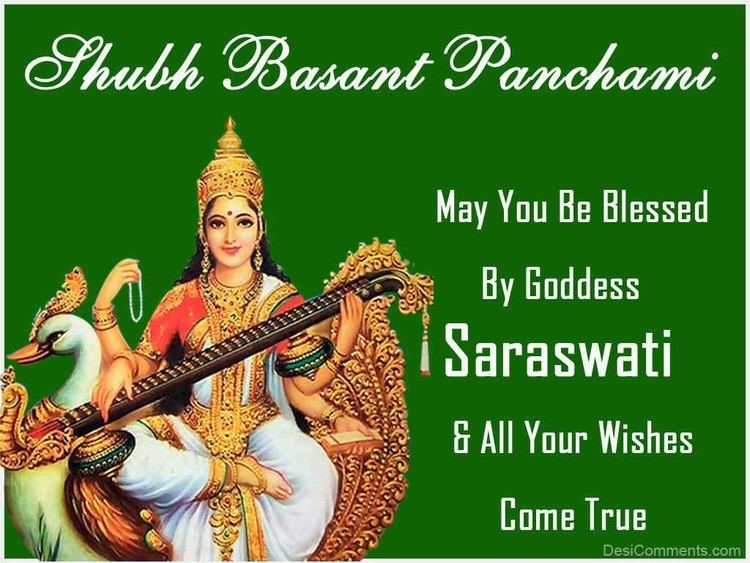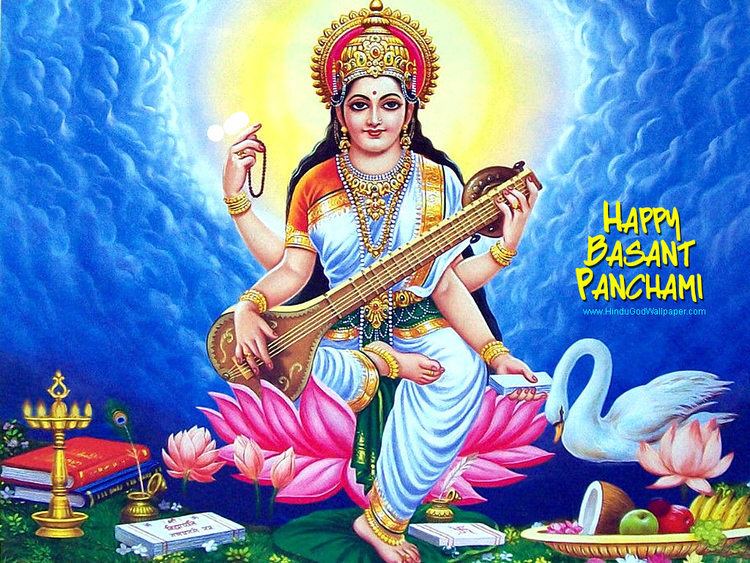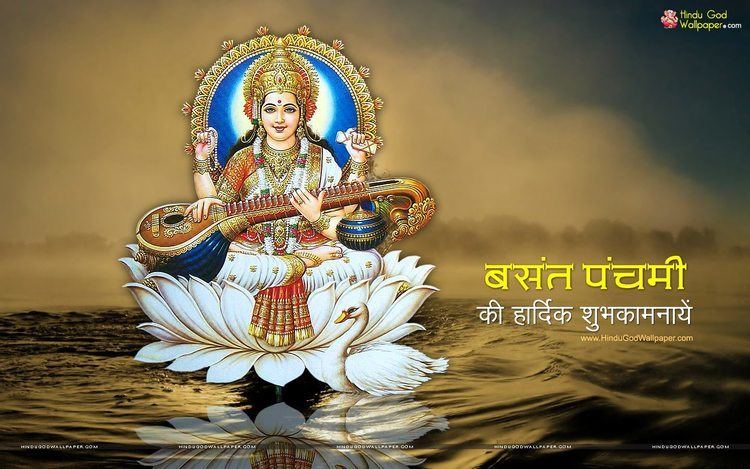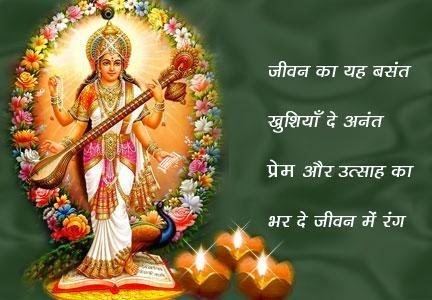2019 date Sunday, 10 February Observances Puja and social functions Featured in religions Hinduism | 2018 date Monday, 22 January 2017 Date 1 February 2017 Type of holiday Religious celebration Also called Basant Panchami | |
 | ||
Celebrations Saraswati puja, Music events, Start studies, Yellow dress, Kite flying | ||
Religious hindu festival of spring vasant panchami
Vasant Panchami, also spelled Basant Panchami, is a Hindu spring festival. It is observed on the fifth day of the Indian traditional calendar month of Magha, which typically falls in the Gregorian months of January or February.
Contents
- Religious hindu festival of spring vasant panchami
- Vasant panchami 2017
- Nomenclature and date
- Goddess Saraswati
- Kamadeva and Rati
- Deo temple Sun God
- Others
- Sikhism
- Pakistan
- Sufi Muslim Basant
- Controversy Inter religious disputes
- References

The festival is celebrated in various ways depending on the region. Many revere goddess Saraswati, the Hindu deity of learning, arts and music. She is celebrated with visits to her temples, by playing music, as well as the day when parents sit down with their children, initiate them into writing letters of alphabet or study together.

Others mark it as the festival of god Kama, the Hindu deity of love, by remembering the loved one particularly one's spouse or special friend, celebrating it with spring flowers. Its link with the god of love and its traditions have led some scholars to call it "a Hindu form of Valentine's Day". Others wear yellow clothes and eat yellow rice to emulate the yellow mustard (sarson) flower fields, or play by flying kites.
The Vasant Panchami also marks the start of preparation for Holika bonfire and Holi, which occurs forty days later.

Vasant panchami 2017
Nomenclature and date

Vasant Panchami has a specific meaning: Vasant means "spring" and Panchami means "the fifth day." Vasant Panchami falls on the fifth day of spring.

Vasant Panchami is celebrated every year on the fifth day of the bright half of the Hindu luni-solar calendar month of Magha, which typically falls in late January or February. It is treated as the start of spring, though it is generally winter-like in northern India, and more spring-like in central and western parts of India.
The festival is particularly observed in the north, central and western parts by Hindus of India and in Nepal. It has been a historical tradition of Sikhs as well.
Goddess Saraswati
For many Hindus, Vasant Panchami is the festival dedicated to goddess Saraswati who is their ancient goddess of knowledge, language, music and all arts. She is the wife of Brahma, and she symbolizes creative energy and power in all its form, including longing and love (kama). The season and festival also reflects the agricultural fields which are ripening with yellow flowers of mustard crop, which Hindus associate with Saraswati's favorite color. People dress in yellow saris or shirts or accessories, share yellow colored snacks and sweets. Some add saffron to their rice then eat yellow cooked rice as a part of an elaborate feast.
Many families mark this day by sitting with babies and young children, encouraging their children to write their first words with their fingers, some just study or create music together. The day before Vasant Panchami, Saraswati's temples are filled with food so that she can join the celebrants in the traditional feasting the following morning. In temples and educational institutions, statues of Saraswati are dressed in yellow and worshiped. Many educational institutions arrange special prayers or pujas in the morning to seek blessing of the goddess. Poetic and musical gatherings are held in some communities in reverence for Saraswati.
In Nepal, Bihar and eastern states of India such as West Bengal, Odisha and Assam, people visit her temples and worship her (Saraswati Puja). In southern states such as Andhra Pradesh, the same day is called Sri Panchami where "Sri" refers to her as another aspect of the one goddess Devi.
Kamadeva and Rati
Another legend behind Vasant Panchami is based on the Hindu god of love called Kama. It is remembered as the day when Parvati approached Kama to wake up Shiva in Yogic meditation since the Maha Shivaratri. The other gods support Parvati, and seek Kama's help to bring Shiva back from his meditation to do his duties in the world. Kama agrees and shoots arrows, made of flowers and bees, at Shiva from his heavenly bow of sugarcane in order to arouse him to pay attention to Parvati. This initiative is celebrated by Hindus as Vasant Panchami.
Vasant Panchami is associated with the emotions of love and emotional anticipation in Kutch (Gujarat), and celebrated by preparing bouquet and garlands of flowers set with mango leaves, as a gift. People dress in saffron, pink or yellow and visit each other. Songs about Krishna pranks with Radha, considered to mirror Kama-Rati, are sung. This is symbolized with the Hindu deity Kamadeva with his wife Rati.
Traditionally, in Maharashtra, Madhya Pradesh, Chhattisgarh and Uttar Pradesh, after bathing in the morning, people worship Shiva and Parvati. Offerings of mango flowers and the ears of wheat are traditionally made.
Deo temple: Sun God
The shrine of the Sun-God in Aurangabad district, Bihar known as the Deo-Sun Shrine, was established on Basant Panchami. The day is celebrated to commemorate the founding of the shrine by King Aila of Allahabad and the birthday of the Sun-Deo God. The statues are washed and old red clothes on them are replaced with new ones on Basant Panchami. Devotees sing, dance and play musical instruments.
Others
People celebrate the day by wearing yellow, eating sweet dishes and display yellow flowers in homes. In Rajasthan, it is customary for people to wear jasmine garlands. In Maharashtra, newly married couples visit a temple and offer prayers on the first Basant Panchami after the wedding. wearing yellow dresses. In the Punjab region, Sikhs and Hindus wear yellow turban or head dress. In Uttarakhand, in addition to Saraswati Puja, people worship Shiva, Parvati as the mother earth and the crops or agriculture. People eat yellow rice and wear yellow. It is also a significant school supplies shopping and related gift giving season.
In the Punjab region, Basant is celebrated as a seasonal festival by all faiths and is known as the Basant Festival of Kites. Children buy Dor (Thread) and Guddi or "Patang" (Kites) for the sport. This tradition is also found in western and northern Indian states of Gujarat, Maharashtra, Rajasthan, Haryana, Uttar Pradesh, Himachal Pradesh. It is also found in part of Madhya Pradesh and some southern states.
Sikhism
Namdhari Sikhs have historically celebrated Basant Panchami to mark the beginning of spring. Other Sikhs treat it as a spring festival, and joyfully celebrate it by wearing yellow colored clothes, emulating the bright yellow mustard flowers in the fields.
Ranjit Singh, the founder of the Sikh Empire, encouraged the celebration of Basant Panchami as a social event in the Gurdwaras. In 1825 CE he gave 2,000 rupees to the Harmandir Sahib Gurdwara in Amritsar to distribute food. He held an annual Basant fair and sponsored kite flying as a regular feature of the fairs. Ranjit Singh and his queen Moran would dress in yellow and fly kites on Basant Panchami. Ranjit Singh would also hold a darbar or court in Lahore on Basant Pachami which lasted ten days when soldiers would dress in yellow and show their military prowess.
In the Malwa region, the festival of Basant Panchami is celebrated with wearing of yellow dress and kite flying. In Kapurthala and Hoshiarpur, a Basant Panchami fair is held. People attend the fair awearing yellow clothes, turbans or accessories. Sikhs also remember the martyrdom of Haqiqat Rai on Basant Panchmi, who was arrested by the Muslim ruler Khan Zakariya Khan. Rai was asked to convert to Islam, but he criticized Muhammad and Islam, and was executed on the Basant Panchami of 1741 in Lahore, Pakistan.
Pakistan
Given the shared history and culture in the Indian subcontinent, the Punjabi Muslims in and around Lahore also celebrate kite flying as a sport in Pakistan from home rooftops during the Basant season.
Sufi Muslim Basant
According to Lochan Singh Buxi, Basant Panchmi is the Hindu festival, but this festival was adopted by some Indian Muslim Sufis in the 12th century to mark the grave of the Muslim Sufi saint dargah of Nizamuddin Aulia in Delhi and ever since it has been observed by the Chishti order. According to local Sufi traditions, the poet Amir Khusrau saw Hindu women carry yellow flowers to a temple on Basant and they were dressed in yellow, and he adopted this practice, one the Chishti order of Sufi Indian Muslims continue to practice.
Controversy: Inter-religious disputes
The Gujarat government has encouraged the observance of Saraswati Puja in schools on Vasant Panchami, a proposal that has been opposed by Indian Muslims because it is a religious festival of Hinduism.
Vasant Panchami has been a historic occasion of dispute at the archaeological site of Bhojshala (Dhar, Madhya Pradesh) with evidence of an early Saraswati temple (locally called Waghdevi). On the site of Bhojshala is a later era Kamal-Maula mosque, which Muslims use for Friday prayers. The Archeological Survey of India (ASI) has provided annual guidelines, when the Vasant Panchami festival falls on a Friday, announcing hours when Hindus can worship at Bhojshala on Vasant Panchami, and when Muslims can. However, in past years, the community scheduled earlier has refused to vacate the premises, leading to riots and disorder such as in 1980s and 1990s.
